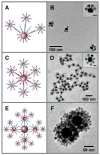Asymmetric functionalization of gold nanoparticles with oligonucleotides
- PMID: 16848436
- PMCID: PMC2525618
- DOI: 10.1021/ja061980b
Asymmetric functionalization of gold nanoparticles with oligonucleotides
Abstract
Gold nanoparticles (AuNPs) were anisotropically functionalized with two different oligonucleotide sequences using magnetic microparticles as geometric restriction templates for site-selective enzymatic extension of particle-bound oligonucleotides. The divalent linking capability of the resulting AuNPs allowed for the design and programmable assembly of discrete nanoparticle heterostructures.
Figures



Similar articles
-
Programmed assembly of peptide-functionalized gold nanoparticles on DNA templates.Langmuir. 2010 Sep 7;26(17):13760-2. doi: 10.1021/la1023554. Langmuir. 2010. PMID: 20672816
-
Transfer of Two-Dimensional Oligonucleotide Patterns onto Stereocontrolled Plasmonic Nanostructures through DNA-Origami-Based Nanoimprinting Lithography.Angew Chem Int Ed Engl. 2016 Jul 4;55(28):8036-40. doi: 10.1002/anie.201512022. Epub 2016 May 19. Angew Chem Int Ed Engl. 2016. PMID: 27194406
-
Synthesis of a multibranched porphyrin-oligonucleotide scaffold for the construction of DNA-based nano-architectures.Org Biomol Chem. 2014 May 7;12(17):2778-83. doi: 10.1039/c4ob00202d. Org Biomol Chem. 2014. PMID: 24668242
-
A Review on the Synthesis and Functionalization of Gold Nanoparticles as a Drug Delivery Vehicle.Int J Nanomedicine. 2020 Dec 7;15:9823-9857. doi: 10.2147/IJN.S279094. eCollection 2020. Int J Nanomedicine. 2020. PMID: 33324054 Free PMC article. Review.
-
DNAzyme-functionalized gold nanoparticles for biosensing.Adv Biochem Eng Biotechnol. 2014;140:93-120. doi: 10.1007/10_2013_242. Adv Biochem Eng Biotechnol. 2014. PMID: 24026635 Review.
Cited by
-
A systems approach towards the stoichiometry-controlled hetero-assembly of nanoparticles.Nat Commun. 2010 Oct 5;1:87. doi: 10.1038/ncomms1089. Nat Commun. 2010. PMID: 20981012
-
Advancements in Nanogels for Enhanced Ocular Drug Delivery: Cutting-Edge Strategies to Overcome Eye Barriers.Gels. 2023 Sep 4;9(9):718. doi: 10.3390/gels9090718. Gels. 2023. PMID: 37754399 Free PMC article. Review.
-
Facile and efficient preparation of anisotropic DNA-functionalized gold nanoparticles and their regioselective assembly.J Am Chem Soc. 2013 Nov 27;135(47):17675-8. doi: 10.1021/ja408033e. Epub 2013 Nov 18. J Am Chem Soc. 2013. PMID: 24148071 Free PMC article.
-
DNA-Assembled Advanced Plasmonic Architectures.Chem Rev. 2018 Mar 28;118(6):3032-3053. doi: 10.1021/acs.chemrev.7b00225. Epub 2018 Jan 31. Chem Rev. 2018. PMID: 29384370 Free PMC article. Review.
-
Monovalent ion-mediated charge-charge interactions drive aggregation of surface-functionalized gold nanoparticles.Nanoscale. 2022 Oct 21;14(40):15181-15192. doi: 10.1039/d2nr02824g. Nanoscale. 2022. PMID: 36214308 Free PMC article.
References
-
- Mirkin CA, Letsinger RL, Mucic RC, Storhoff JJ. Nature. 1996;382:607–609. - PubMed
- Mucic RC, Storhoff JJ, Mirkin CA, Letsinger RL. J Am Chem Soc. 1998;120:12674–12675.
- Gothelf KV, LaBean TH. Org Biomol Chem. 2005;3:4023–4037. - PubMed
- Katz E, Willner I. Angew Chem, Int Ed. 2004;43:6042–108. - PubMed
- Niemeyer CM, Ceyhan B, Hazarika P. Angew Chem, Int Ed. 2003;42:5766–5770. - PubMed
- Bates AD, Callen BP, Cooper JM, Cosstick R, Glidle A, Jaeger L, Pearson JL, Proupin-Perez M, Xu C, Cumming DRS. Nano Lett. 2006;6:445–448. - PubMed
- Le JD, Pinto Y, Seeman NC, Musier-Forsyth K, Taton TA, Kiehl RA. Nano Lett. 2004;4:2343–2347. - PubMed
- Zhang J, Liu Y, Ke Y, Yan H. Nano Lett. 2006;6:248–251. - PubMed
- Mbindyo JKN, Reiss BD, Martin BR, Keating CD, Natan MJ, Mallouk TE. Adv Mater. 2001:249–254.
- Cobbe S, Connolly S, Ryan D, Nagle L, Eritja R, Fitzmaurice D. J Phys Chem B. 2003;107:470–477.
- Sadasivan S, Dujardin E, Li M, Johnson CJ, Mann S. Small. 2005:103–106. - PubMed
-
- Rosi NL, Mirkin CA. Chem Rev. 2005;105:1547–1562. - PubMed
-
- Glotzer SC. Science. 2004;306:419–420. - PubMed
-
- Zanchet D, Micheel CM, Parak WJ, Gerion D, Williams SC, Alivisatos AP. J Phys Chem B. 2002;106:11758–11763. - PubMed
Publication types
MeSH terms
Substances
Grants and funding
LinkOut - more resources
Full Text Sources
Other Literature Sources

